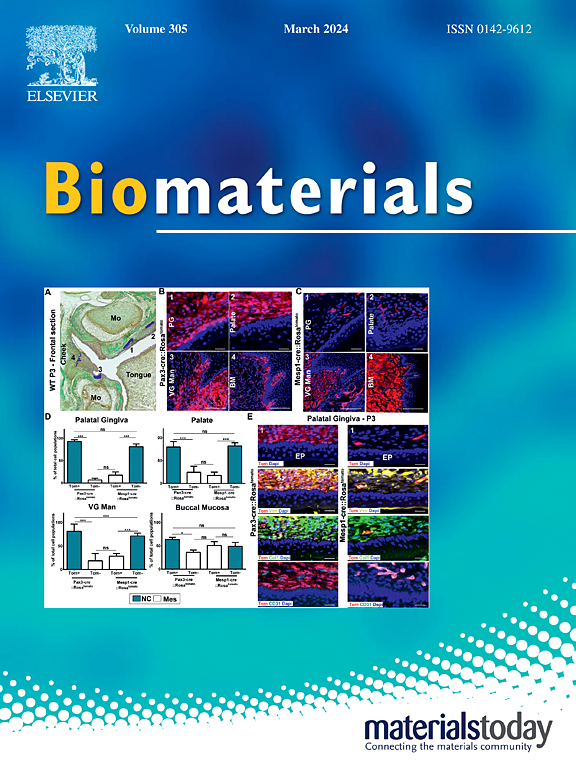嵌合微图揭示细胞形状和细胞核形状对上皮-间质转化的影响。
IF 12.9
1区 医学
Q1 ENGINEERING, BIOMEDICAL
引用次数: 0
摘要
上皮-间质转化(Epithelial-mesenchymal transition, EMT)是癌症转移的关键表型转换,可导致患者致命的后果。在几何约束下,癌细胞的形态在细胞和亚细胞水平上发生变化,然而,其对EMT的影响尚不完全清楚。在此,我们设计并制作了聚苯乙烯(PS)的嵌合微图,并进行了粘附对比,以揭示细胞形状和核形状对EMT的解耦影响。通过微孔长径比(ARs)调节细胞伸长,并通过微孔中的微柱阵列产生核变形。将人非小细胞肺癌细胞(A549)培养在准三维微图案表面,加入转化生长因子-β1 (TGF-β1)诱导EMT。我们发现嵌合微模式在TGF-β1作用下上调EMT,增加细胞AR和核压痕。随后对微丝的收缩性和定向组装的评估阐明了机械转导在细胞伸长和EMT中的关键作用,正如肌球蛋白抑制所证明的那样,而在嵌合微模式中被微柱阻碍。因此,微柱阵列具有非单调影响,增强了AR为1的细胞的EMT,但阻碍了EMT,由于阻碍了细胞骨架组装,对AR较大的微孔的影响更为显著。这项基础研究阐明了细胞和亚细胞的复杂几何形状对细胞行为的影响,包括癌症转移中的表型转变。本文章由计算机程序翻译,如有差异,请以英文原文为准。

Effects of cell shape and nucleus shape on epithelial-mesenchymal transition revealed using chimeric micropatterns
Epithelial-mesenchymal transition (EMT) is a key phenotypic switch in cancer metastasis, leading to fatal consequences for patients. Under geometric constraints, the morphology of cancer cells changes in both cellular and subcellular levels, whose effects on EMT are, however, not fully understood. Herein, we designed and fabricated chimeric micropatterns of polystyrene (PS) with adhesion contrast to reveal the impacts of cell shapes and nuclear shapes on EMT in a decoupled way. Cell elongation was modulated via microwell aspect ratios (ARs), and nuclear deformation was generated through a micropillar array in the microwell. Human non-small cell lung cancer cells (A549) were cultured on the quasi-three dimensional micropatterned surfaces, and transforming growth factor-β1 (TGF-β1) was added to induce EMT. We found that chimeric micropatterns upregulated EMT with an increase of cellular AR and nuclear indentation under given TGF-β1. The subsequent assessment of the contractility and oriented assembly of microfilaments elucidated the key role of mechanotransduction in cell elongation and EMT, as proved by myosin inhibition, while it was obstructed by micropillars in the chimeric micropattern. Hence, the micropillar array possessed a nonmonotonic influence, enhancing the EMT of cells with AR of 1, but hindering the EMT with an impact more significant on microwells with large ARs due to the impeded cytoskeleton assembly. This fundamental research has illustrated the complex of cellular and subcellular geometries on cell behaviors including phenotype transition in cancer metastasis.
求助全文
通过发布文献求助,成功后即可免费获取论文全文。
去求助
来源期刊

Biomaterials
工程技术-材料科学:生物材料
CiteScore
26.00
自引率
2.90%
发文量
565
审稿时长
46 days
期刊介绍:
Biomaterials is an international journal covering the science and clinical application of biomaterials. A biomaterial is now defined as a substance that has been engineered to take a form which, alone or as part of a complex system, is used to direct, by control of interactions with components of living systems, the course of any therapeutic or diagnostic procedure. It is the aim of the journal to provide a peer-reviewed forum for the publication of original papers and authoritative review and opinion papers dealing with the most important issues facing the use of biomaterials in clinical practice. The scope of the journal covers the wide range of physical, biological and chemical sciences that underpin the design of biomaterials and the clinical disciplines in which they are used. These sciences include polymer synthesis and characterization, drug and gene vector design, the biology of the host response, immunology and toxicology and self assembly at the nanoscale. Clinical applications include the therapies of medical technology and regenerative medicine in all clinical disciplines, and diagnostic systems that reply on innovative contrast and sensing agents. The journal is relevant to areas such as cancer diagnosis and therapy, implantable devices, drug delivery systems, gene vectors, bionanotechnology and tissue engineering.
 求助内容:
求助内容: 应助结果提醒方式:
应助结果提醒方式:


